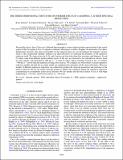THE THREE-DIMENSIONAL STRUCTURE OF INTERIOR EJECTA IN CASSIOPEIA A AT HIGH SPECTRAL RESOLUTION
Author(s)
Isensee, Karl; Rudnick, Lawrence; DeLaney, Tracey; Smith, J. D.; Rho, Jeonghee; Reach, William T.; Kozasa, Takashi; Gomez, Haley; ... Show more Show less
DownloadIsensee-2010-THE THREE-DIMENSIONA.pdf (2.677Mb)
PUBLISHER_POLICY
Publisher Policy
Article is made available in accordance with the publisher's policy and may be subject to US copyright law. Please refer to the publisher's site for terms of use.
Terms of use
Metadata
Show full item recordAbstract
We used the Spitzer Space Telescope's Infrared Spectrograph to create a high-resolution spectral map of the central region of the Cassiopeia A (Cas A) supernova remnant, allowing us to make a Doppler reconstruction of its three-dimensional structure. The ejecta responsible for this emission have not yet encountered the remnant's reverse shock or the circumstellar medium, making it an ideal laboratory for exploring the dynamics of the supernova explosion itself. We observe that the O, Si, and S ejecta can form both sheet-like structures and filaments. Si and O, which come from different nucleosynthetic layers of the star, are observed to be coincident in velocity space in some regions, and separated by 500 km s–1 or more in others. Ejecta traveling toward us are, on average, ~900 km s–1 slower than the material traveling away from us. We compare our observations to recent supernova explosion models and find that no single model can simultaneously reproduce all the observed features. However, models of different supernova explosions can collectively produce the observed geometries and structures of the interior emission. We use the results from the models to address the conditions during the supernova explosion, concentrating on asymmetries in the shock structure. We also predict that the back surface of Cas A will begin brightening in ~30 years, and the front surface in ~100 years.
Date issued
2010-12Department
MIT Kavli Institute for Astrophysics and Space ResearchJournal
Astrophysical Journal
Publisher
Institute of Physics/American Astronomical Society
Citation
Isensee, Karl, Lawrence Rudnick, Tracey DeLaney, J. D. Smith, Jeonghee Rho, William T. Reach, Takashi Kozasa, and Haley Gomez. “THE THREE-DIMENSIONAL STRUCTURE OF INTERIOR EJECTA IN CASSIOPEIA A AT HIGH SPECTRAL RESOLUTION.” The Astrophysical Journal 725, no. 2 (December 3, 2010): 2059–2070. © 2010 American Astronomical Society.
Version: Final published version
ISSN
0004-637X
1538-4357